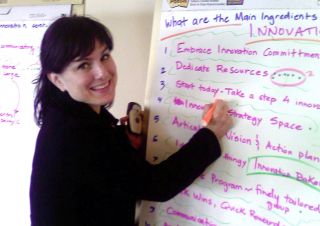Cross-Cultural Psychology
Why Many Brainstorms Suck
Three reasons why your company sucks at brainstorming, and how to fix them.
Posted October 20, 2012

Innovation guru John Kao proposed in his landmark book Jamming, that brainstorming is like making music – that if you enjoy some natural talent at inventing and combine it with some training and dedicated practice, you can someday become a "concert quality innovator" leading brainstorms that stimulate blissful co-invention, enable deep collaborative thinking, and produce ideas that can literally change the world.
At their best, brainstorms offer a rare opportunity during the typical business grind to let the brain’s pedal hit the metal, open it up, and let your collective creativity fly. Unfortunately, without training or natural skill at the art of managing "group ideation processes", brainstorming can be pretty ineffective and a waste of valuable corporate resources. At such times, brainstorms turn into a gloomy confirmation of the worst qualities of your corporate culture. There are many, many ways to kill a brainstorm and suck the life out of their participants. Where do we begin?
Let me paint a fictional scenario of a worst case scenario for a brainstorm: (step 1) the domineering CEO runs the brainstorm and after kicking off the meeting by explaining his great idea for 30 minutes, he pans every nascent idea or ideational riff with nothing more than the amazing power of his facial expressions, (step 2) he’s only invited his yes men and maybe a token woman or minority – that usually means you, and finally, (step 3) you find out they only invited you to take notes – so you really can’t participate because you're too busy preserving their brilliant ideas for posterity. The only thing worse is if you managed to squeak and contributed the seed of a novel and promising idea… which the CEO must now steal and then fire you to bury the truth about where he stole it from.
Okay, I’m exaggerating a bit, but you get the idea. This fictional scenario vividly illustrates some of the key reasons why your company’s brainstorming sessions don’t really work. Let’s drill down on the top three causes for brainstorm suckage --
First, great brainstorms require great facilitation, and unless you’ve had some formal training in this art - which is as complex a creative process as directing a motion picture - these freeform mental free-for-alls can often turn into an exercise in herding cats. You need to learn how to subtly direct the flow of ideation, like the invisible hand of commerce. Another task is to provide persuasive encouragement to participants not to “plop” on ideas. Plopping is to pan an idea before it has a chance to blossom, and some people are so good at being judgmental and negative, that they can pan an idea with a sigh or subconscious facial expression.
Here’s a brainstorming exercise you can try to see the effect of plopping: First, take three participants, put them at the front of the room, and ask them to come up with as many inventions as fast as they can for a futuristic kitchen… but instructing the rest of the participants to react negatively to the ideas. Do this for three minutes and count the number of decent ideas. Then ask the same participants to do it again for a futuristic bathroom… but have everyone strongly and authentically appreciate the ideas and cheer them on. The results will be startling. This is why brainstorm facilitators use a “no plopping” rule.
There’s another very key skill that’s required – something I call multi-visioning. Like a sculpture that needs to be turned for the sculptor to capture all perspectives, an idea needs to be turned in our minds to fill itself out. The way it works is that the facilitator encourages the natural flow of ideas until the ideation momentum ebbs, and when that happens, a great facilitator pivots to a new conceptual perspective. Essentially, it’s the art of asking the right questions to restimulate thinking.
[Note: Multi-visioning is described more fully in an earlier post.]
Second, it is vital to make sure that an effective combination of expertise and background is included in the composition of brainstorm participants. So when a CEO invites only his executive team or the CTO invites only engineers to a brainstorming, you’ll never get the range of ideas that a truly diverse team can generate.

The TV show "House" — a medical Sherlock Holmes.
Why do you need diversity? It's like in that terrific TV series House – in which a small team of terribly attractive doctors works under a brilliant but cantankerous diagnostician in a metropolitan hospital. Each week the team convenes in a hospital “situation room” to brainstorm on a whiteboard possible causes for the rare and perplexing symptoms presented. Usually, the condition worsens and Dr. House and team go back to the drawing board… fortunately, the treatment failures become additional clues that solve the puzzle and the disease is cured around page 30 of the script.
The secret diagnostic weapon for this team is a technique called differential diagnosis – making and generating a differential list of symptoms and causes. Each of the doctors on House's team is a specialist, so by bringing together a diverse team that span the medical knowledge stovepipes, they can come up with better diagnoses. And when all else fails, House will break into the patient’s home to see what’s s/he is hiding, because it is sometimes necessary to examine the patient’s environment to look for causes that nobody thought important enough to mention in the medical context. This is actually an important tool, since most great solutions are often hidden in plain sight...
For non-medical brainstorm, the same kind of principles apply. As an exercise, you can reprise that brainstorming exercise from before -- but this time, start with three men, all senior managers. Let them brainstorm for five minutes about inventions for the living room. Again, count the number of decent ideas. Then add seven more people from all levels of the organization, with diversity of race, gender and hierarchy. Plus one more thing – to reverse the possibility that they don’t want to embarrass senior management – offer $10 per idea. Then run the experiment again, this time inventing stuff for the bedroom.
[Note: I haven’t had a chance to run this exercise yet. If you can talk your company into performing this experiment, please send me the results so we can publish it here. Send me the number of ideas generated, as well as the idea lists. For extra credit, ask a couple of the participant to ethnographically observe the exercise, and take notes.]
The point is this – tasked with generating truly novel solutions or disruptive innovations, a team has to be not only great at coming up with ideas, but diverse enough to avoid structural factors that inhibit ideation output – specifically hierarchical bias, gender bias, and motivational gap. So next time you set up a brainstorming, invite the admins, the receptionist, your favorite customers and your less favorite customers… and then throw in a few external innovation experts, I call them spark plugs.
Trust me on this… diversity works.
Finally, the third reason: someone is tasked to take copious notes – cramping their ability to participate. Ideation is based in the creative side of the brain, and taking notes tends to activate the other side of the brain. It destroys momentum, dissipates the creative energy, and distracts from the true goal – teaching your team how to think without the shackles.
The solution is to hire a trained “visual ideation” meeting recorder, who will use something called Group Graphics to visually annotate your meeting. Group Graphics was invented by David Sibbet, the author of Visual Meetings, a book that teaches Sibbet’s powerful process of interactive, panoramic, real-time visualization of group creative output. Sibbet’s powerful visual tools for meeting management are used throughout Silicon Valley to facilitate both face-to-face and virtual group work.

These tools – graphic recording, visual planning, story boarding, graphic templates, idea mapping – are creative ways to energize brainstorming, team building, strategy sessions. It’s the first brilliant step toward an emerging visual language for leading groups. Oh, and by the way, the facilitator and the recorder should never be the same person, so be sure to hire both for your next brainstorming session and see how much of a difference it makes.
In conclusion, if you can correct and change these three factors in the production of your next brainstorming, you’ll be able to go from brainstorms that absolutely suck to brainstorms that absolutely shine. Then you’ll see how brainstorming sessions are a barometer for the overall innovativeness of your organization. And if you can pull off a single decent brainstorm, that’s both the first step toward changing the way things are done, and a giant leap toward transforming the DNA of the embedded culture.




